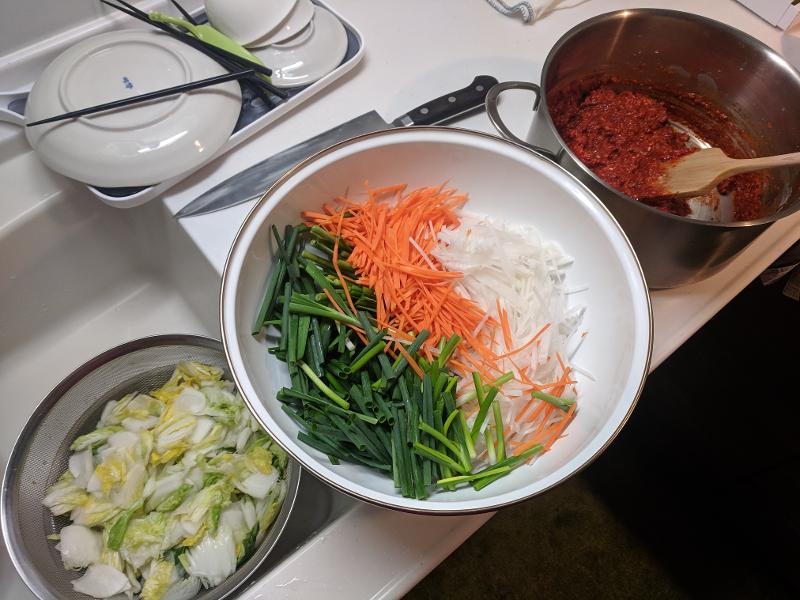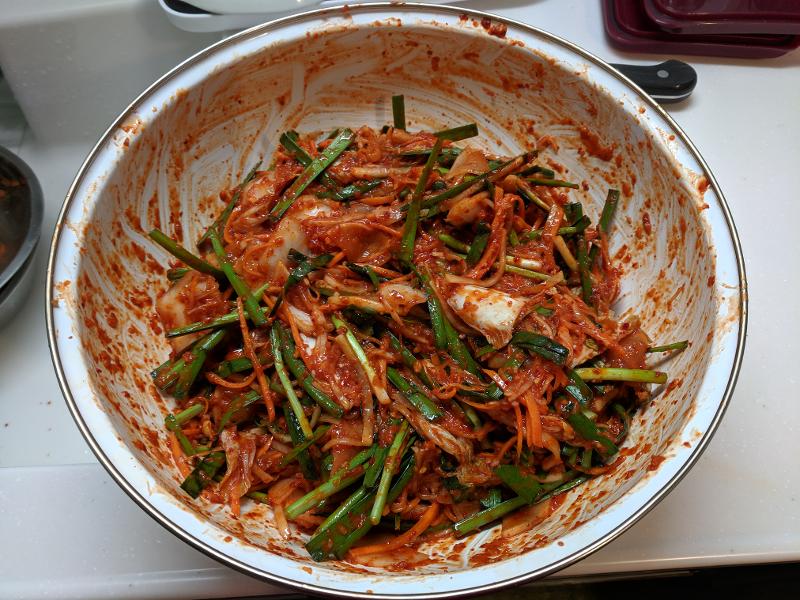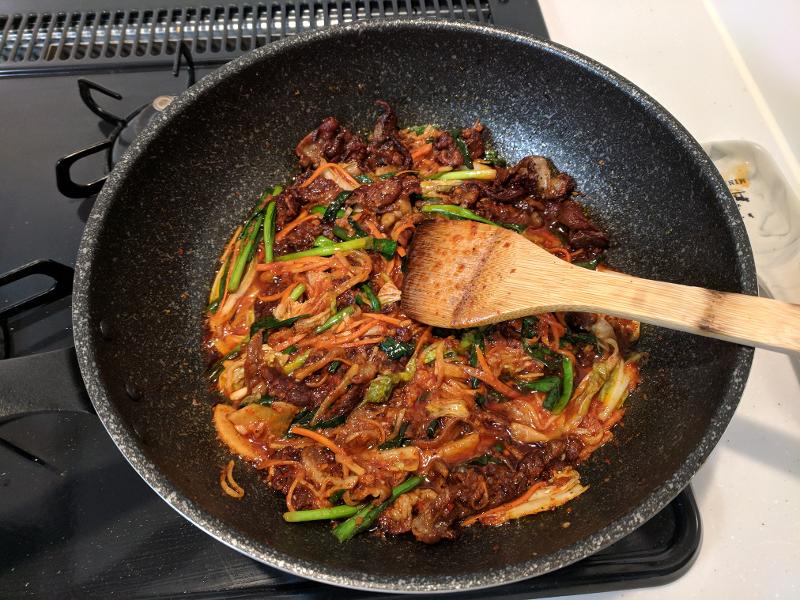Since I finally posted this on Reddit, figured you guys might like it too. 
Note that I'm shredding the cabbage first. If you prefer not to do that, check here for the technique and adjust appropriately.
This is for 1/4 head of cabbage, but there's a significant volume of veggies, so it ends up making quite a bit of kimchi. Also, there's a lot of ranges here; this recipe was provided to me as "yeah, this much" and "put enough of that in." So it's all open to interpretation, but at this point I've made it enough times that anything in any of the ranges below should come out well.
Daikon
1 6" chunk of daikon (~800g)
Slice half of this thinly into 1" square-ish pieces. Julienne the other half.
Note: If you have an entire daikon that's only 6" long, that's probably not enough. Get two. We use about 6" of a daikon that's likely to measure at least a foot and a half.
Cabbage
1/4 head Napa cabbage (~900g)
1/4 C pickling salt
Tear this roughly by hand into 2"-3" pieces.
Sauce
1 med carrot, julienne
1 bn nira (garlic chives), chopped 1" long
1 bn scallions, chopped 1" long
1/4 - 1/3 C fish sauce
1/4 - 1/3 C shrimp sauce
2 T finely chopped ginger
4 T finely chopped garlic
1/2 - 1 C Korean ground red pepper
1 med onion, blended
2 T erythritol or sugar (optional)
1-2 T plum extract (optional)
Slurry
2-3 T glutinous rice flour
Water
Method
If that's a problem for you, instead of this method, use a salt brine to cure the cabbage initially. Mix in enough salt so you can clearly taste it in the brine but not so much that it's hard to stomach; that's not a great measurement, but that's how it's done, at least in my family. Everything else stays the same, but with only a very brief rinse when straining the kimchi.
I don't have a picture of this by itself, but you can see it among friends here, in my kimchi fridge. It's in the green-lidded jars on the top shelf, though that's far less than half the batch.

Note that I'm shredding the cabbage first. If you prefer not to do that, check here for the technique and adjust appropriately.
This is for 1/4 head of cabbage, but there's a significant volume of veggies, so it ends up making quite a bit of kimchi. Also, there's a lot of ranges here; this recipe was provided to me as "yeah, this much" and "put enough of that in." So it's all open to interpretation, but at this point I've made it enough times that anything in any of the ranges below should come out well.
Daikon
1 6" chunk of daikon (~800g)
Slice half of this thinly into 1" square-ish pieces. Julienne the other half.
Note: If you have an entire daikon that's only 6" long, that's probably not enough. Get two. We use about 6" of a daikon that's likely to measure at least a foot and a half.
Cabbage
1/4 head Napa cabbage (~900g)
1/4 C pickling salt
Tear this roughly by hand into 2"-3" pieces.
Sauce
1 med carrot, julienne
1 bn nira (garlic chives), chopped 1" long
1 bn scallions, chopped 1" long
1/4 - 1/3 C fish sauce
1/4 - 1/3 C shrimp sauce
2 T finely chopped ginger
4 T finely chopped garlic
1/2 - 1 C Korean ground red pepper
1 med onion, blended
2 T erythritol or sugar (optional)
1-2 T plum extract (optional)
Slurry
2-3 T glutinous rice flour
Water
Method
- Using your hands, gently but thoroughly fold salt into cabbage. Let rest for 45 minutes.
- Add squared daikon and combine. Let rest another 45 minutes.
- Thoroughly rinse cabbage and daikon and rest in a strainer.
- Combine rice flour with enough water to dissolve; simmer down into a very thick paste. Let cool.
- Mix flour paste with all sauce ingredients, including julienned daikon.
- Combine all ingredients. Pack loosely into jars.
- Let rest on counter for several days up to two weeks, tasting occasionally. Refrigerate when it's almost as sour as you prefer it.
If that's a problem for you, instead of this method, use a salt brine to cure the cabbage initially. Mix in enough salt so you can clearly taste it in the brine but not so much that it's hard to stomach; that's not a great measurement, but that's how it's done, at least in my family. Everything else stays the same, but with only a very brief rinse when straining the kimchi.
I don't have a picture of this by itself, but you can see it among friends here, in my kimchi fridge. It's in the green-lidded jars on the top shelf, though that's far less than half the batch.





